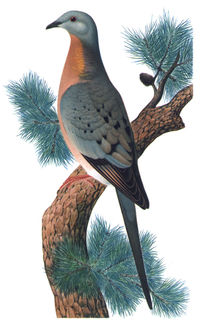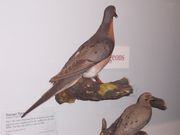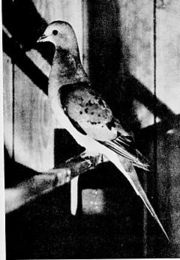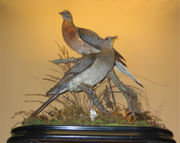Passenger Pigeon
2007 Schools Wikipedia Selection. Related subjects: Birds
| iPassenger Pigeon | ||||||||||||||
|---|---|---|---|---|---|---|---|---|---|---|---|---|---|---|
 Male Passenger Pigeon--chromolithograph
|
||||||||||||||
|
|
||||||||||||||
|
Extinct ( 1914)
|
||||||||||||||
| Scientific classification | ||||||||||||||
|
||||||||||||||
|
|
||||||||||||||
| Ectopistes migratorius (Linnaeus, 1766) |
The Passenger Pigeon (Ectopistes migratorius) is an extinct species of pigeon that was once probably the most common bird in the world . It is estimated that there were as many as five billion Passenger Pigeons in the United States. They lived in enormous flocks—the largest of them a mile (1.6 km) wide and 300 miles (500 km) long, taking several days to pass and probably containing two billion birds.
In the 18th century, the Passenger Pigeon in Europe was known to the French as "tourtre" but in New France the North American bird was called "tourte". In modern French the bird is known as the pigeon migrateur.
In Algonquian languages, it was called amimi by the Lenape and omiimii by the Ojibwe.
Life and extinction
The Passenger Pigeon was a very social bird. It lived in colonies stretching over hundreds of square miles, with up to a hundred nests in a single tree. During summer, Passenger Pigeons lived throughout the part of North America east of the Rocky Mountains. In the winter, they lived in the southern U.S.
The Passenger Pigeon was extensively hunted for food, hog feed, as live targets for trap shooting and even sometimes as agricultural fertilizer, and shipped by the boxcar-load to the Eastern cities. In New York City, in 1805, a brace (pair) of pigeons sold for two cents. Slaves and servants in 18th and 19th century America often saw no other meat. Commercial hunters harvested them in huge amounts for food, and most restaurants in the Eastern United States served pigeon to customers. 3 million pigeons were shipped by a single market hunter in the year 1878. Alcohol-soaked grain intoxicated the birds and made them easier to kill. Smoky fires were set to nesting trees, causing the young birds to jump from their nests into hunters bags. All these factors greatly contributed to the Passenger Pigeon's extinction in the early 20th century.
In the mid-1800s, it was noticeable that their numbers were dropping. The Passenger Pigeon only laid one egg at a time, so once numbers started to decline it would have taken time for them to start rising again.
Other significant reasons for its extinction were deforestation (the birds relied on acorn and beech mast for breeding and shifted or occupied their breeding colonies in accordance with the food trees' mast year cycle), and probably social factors—the birds seemed to have initiated courtship and reproduction when they were gathered in large numbers; it was noted that small groups of Passenger Pigeons were notoriously difficult to get to breed successfully.
Martha
The last Passenger Pigeon, named Martha, died in the Cincinnati Zoo on September 1, 1914. She was frozen into a block of ice and sent to the Smithsonian Institution and was skinned and mounted. Martha is no longer on display, but is in the archived collection.
Popular Culture
- The musician John Herald wrote a song about Martha: "Martha (Last of the Passenger Pigeons)". Also, the indie rock band Paint by Numbers wrote a song titled "Sweet Sweet Martha" to commemorate her death.
- The April 27, 1948 episode of the Fibber McGee and Molly radio program is titled "The Passenger Pigeon Trap", in which McGee claims to have seen a Passenger Pigeon (he insists that the bird is " stinct") and plans to trap it in order to sell it to the highest bidder. It turns out to be nothing more than a Rock Pigeon (Columba livia) sitting on top of a bus, which in McGee's mind makes the pigeon a passenger.
- In " The Man Trap," the premiere episode of Star Trek, Professor Crater likens the near-extinction of the inhabitants of planet M113 to the demise of the passenger pigeon.
- Stephen King makes a number of references to the Passenger Pigeon in the 2005 Novel " Cell". He uses the Passenger pigeon as an allegory to the new human hive mind that develops after the pulse hits the United States.
- In the 1999 movie by Jim Jarmusch, Ghost Dog: The Way of the Samurai, Louie ( John Tormey) identifies the bird owned by the titular character as a " carrier pigeon". He is corrected by an elderly mafioso who shouts, "Passenger pigeon! Passenger pigeon! They've been extinct since 1914!" (The bird was in fact one of the homing pigeons Ghost Dog used to transport - "carry" - notes, which explains Louie's misidentification).
- The term "stool pigeon" was first coined when Passenger Pigeons were captured, had their eyelids sewn shut, and were tied to stools. The birds sitting on the stools would be used as live decoys so Pigeon hunters would have an easier shot at their quarry. Today it is a term used for an unscrupulous person giving information about someone's misbehaviour or illegal activity .
- Ectopistes Migratorius is the second chapter of the novel Havana Glam ( 2001) by Wu Ming 5. The reapperance of the pigeons in 1944 is the first signal of the arrival of time travellers from XXI century USA
Across North America, place-names refer to the former abundance of the Passenger Pigeon. Examples include:
- Pigeon Forge, Tennessee
- Pigeon Rivers in: Minnesota-Ontario, North Carolina/Tennessee, Michigan (four), and Wisconsin
- Pigeon Lakes: Minnesota, Wisconsin
- Pigeon Roost, Indiana
- Crockford Pigeon Mountain, Georgia
- Mimico, a neighbourhood of Toronto, Ontario, Canada. The name means "The Place of the Passenger Pigeons".
Coextinction

An often-cited example of coextinction is that of the Passenger Pigeon and its parasitic lice Columbicola extinctus and Campanulotes defectus. Recently, C. extinctus was rediscovered on the Band-tailed Pigeon, and C. defectus was found to be a likely case of misidentification of the existing Campanulotes flavus. However, even though the story of Passenger Pigeon lice has a happy ending (rediscovery), it is uncertain whether coextinctions of other parasites, even on the Passenger Pigeon, have occurred.


